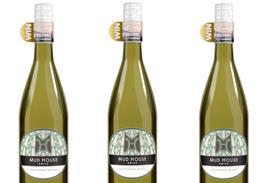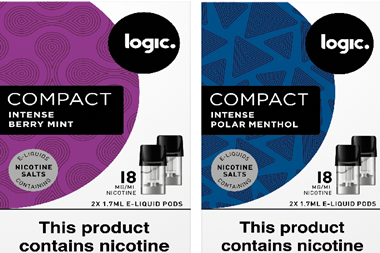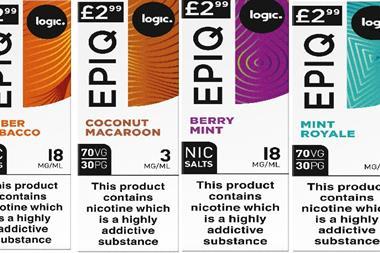Manny Patel, Manny’s Convenience Store, Long Ditton, Surrey
Stretched for space, Manny has a strict one-in, one-out policy when it comes to stocking new products
Chaz Chahal, Costcutter Bromsgrove and Kidderminster
Chaz is emabarking on a massive range review to cut back on the number of skus he stocks
Rishi Madhani, Today’s Stokenchurch, Buckinghamshire
Rishi follows his head rather than his heart when it comes to stocking new products to ensure a tight range
Linda Williams, Premier Broadway, Edinburgh
Linda and Dennis Williams recently culled over 200 lines from their store to make space for promotional items
Has the number of skus in your store increased or decreased over the past year?
Manny: We currently stock over 5,000 lines. When we print a stock list it runs to over 27 pages. It’s definitely increased over the past year with brands bringing out more lines and really stretching the space in our store.
Chaz: It’s increased. Stores have felt the need to be like supermarkets and stock every line going without having the space. I’m trying to cut back on my range and just have a core range.
Rishi: It’s remained pretty static at about 4,000 lines over the past year. I like to keep some discipline on ranging and try not to put an item in just for the sake of it. This can be tough to do with the number of new products coming onto the market.
Linda: We cut our range to around 2,500 lines a few months ago to make space for promotional bays. Our range was reduced by around 200 lines which freed up a lot of space for that and helped the store seem much bigger.
How often do you conduct range reviews?
Manny: Every month. It’s always been this way. You need to keep on top of your range or else it’s wasted space. If there’s a product that hasn’t been selling well, it’s important to identify it quickly and either move it to another part of the store or delist it. We don’t have enough space for products that don’t sell.
Chaz: It’s an ongoing process. We focus on a category every three weeks to fit in with promotions as that’s when new products start coming in. It’s important that a load of new lines don’t get added and it becomes too big.
Rishi: I look at a category every other month and see how sales are performing. If sales are down then I look at the products that aren’t selling and delist where appropriate. I try to give any extra space made to existing lines that are doing well rather than throwing new products in straight away.
Linda: It’s done on a rolling basis to keep on top of it. We work with our sales reps to make sure every line we’re stocking deserves its place. There are always products you think are doing well but, when you look at the epos data, you find they aren’t, so you need to be looking at your range all the time otherwise you’ll get caught out.
Is there a category you’ve cut back on recently?
Manny: Greeting cards have been on the decline for a while. People are using ecards more often which has hurt the category. I’ve also cut back on some confectionery and grocery lines because they were getting too big and needed to be trimmed back for other categories.
Chaz: I’m cutting back on cooking sauces and pastas right now because I think we’re over-subscribed in that area. I’m not sure customers want nine different variants with different flavours when they come into a convenience store so I’m cutting that back to the basics.
Rishi: Condiments have been cut back on because I had too many lines. Previously I would stock something because I thought it might be nice but now I stick to lines that I’m confident will sell.
Linda: I’ve cut back on ambient grocery. There’s still a market for the category but it’s not necessary to carry as much of it as before. Customers are shopping differently now with much more of a focus on fresh foods.
Is there a category you’ve increased recently?
Manny: I’ve given more space to chilled foods and ready meals. People’s lifestyles are changing and they want to be able to pick up dinner on the way home from work. I installed a chiller and the category is already doing very well.
Chaz: Not really. I’m more focused on ensuring I have availability on the core lines rather than increasing categories. I think independent retailers can be a bit too trigger happy when it comes to adding new products so I want to cut back now across the board.
Rishi: We’ve expanded our fresh produce section in line with customer demand. Our horticultural section has grown due to the amount of developers, landscape gardeners and property managers placing orders with us for plants and shrubs.
Linda: Fresh and chilled has grown in our store. The healthy eating message has hit home and shoppers are realising that you can eat well for not much money and are really buying into fresh produce.
Who do you rely on for category management advice?
Manny: Epos data and my gut instinct. Planograms are too generic and don’t fit every store. A retailer should be able to know what works in his store and where a category needs to go. I know where the best place for items are that will generate the most sales.
Chaz: Trade press such as C-Store is good for NPD and following trends such as premium coffee, which I didn’t think would work at our store but has been very successful for us. Your epos data can be a treasure trove of information if you use it correctly.
Rishi: Today’s Plan for Profit website is always our first port of call although it’s more of a general guide to categories than specific to one store. I refer to manufacturer websites a lot because I often need the information quickly.
Linda: It’s a combination of epos data and working with manufacturers. We’ll work with reps whenever possible to get advice on range and couple that with sales data to see what’s selling and what isn’t. Local knowledge is also important because shoppers in different areas want different things.
Which category do you find the most difficult to manage?
Manny: Fruit and vegetables is tough. You have to keep on top of the sell by date and the quality control otherwise there’s no point in doing it. Frozen is tricky as well, it can be an overlooked category that can end up costing you money if you don’t take care of it.
Chaz: The not-so-sexy categories like grocery can be tough to manage as they can be a lot of work for not that much reward as someone may buy an extra can of beans but they probably won’t fill up their basket in that aisle.
Rishi: Wine is a minefield. There are so many products out there that it can be tough deciding what to stock if you’re not an expert. It’s an area we need more specialist help in but it’s the trickiest to source information on.
Linda: I’m never completely satisfied with my biscuit display. There are too many pricemarked packs and products on promotion to keep it steady. Customers shop the category differently now, previously they had favourites but now they just want value. It’s tough to keep on top of the range and keep it looking good.
Have you introduced any new categories in the past 12 months?
Manny: Chilled is a new category for the store. We realised that it was becoming a popular category and we needed to capitalise on it. It’s been a good move for us and certainly worth doing.
Chaz: Ecigarettes and vaping products are the newest trend and worth keeping on top of.
Rishi: When we conducted a refit at the store we added a pound zone to help us offer more value to customers. It needs some love and the range changes a lot but it’s worth having as I think it’s important to grow value perception in our channel.
Linda: We added three bays of promotional displays including a pound zone that has stationary, pet care and snacks in it. It was a good move for us and most of the lines are flying out.
What’s your criteria for deciding on stocking a new product?
Manny: Space is at a premium so if a trade rep comes in with a new product, I ask them which of their products I should delist to make space for it. They rarely have an answer. I look at the price, if the brand is well known I’ll weigh up if it’ll do well in my area. I do usually have a one in, one out policy but then it’s tough deciding which product to delist.
Chaz: We look at who the manufacturer is, what support is behind it and if we think it’ll work in our store. I don’t necessarily delist an item when a new one comes in as I think it’s important for independent stores to be flexible with their range and offer up something different to customers.
Rishi: I assess what support there is for retailers first. A national marketing campaign is all well and good but if manufacturers give us product and POS materials and let us know about it early, that makes the decision easy for us. Manufacturers that visit us also have more of a chance of getting their product stocked as it makes a big difference to meet someone from the brand and talk it through with them.
Linda: It’s very rare that a completely new product from an unknown brand will make it into the store. We look at the manufacturer and whether there’s ad spend because that generates interest from customers. If it’s a variant of an existing line we’ll give it a chance but if it doesn’t sell, we’ll get rid of it quickly.
Dedicated staff
Do you have dedicated staff members for certain categories?
Manny: No, we don’t have many staff so that wouldn’t work for us. Everyone who works for us is encouraged to keep an eye on all categories. We prefer that our staff know about all the store rather than focusing on one area.
Chaz: We split it up into separate categories for different staff members. It’s impossible to expect every employee to know about every category in the store so this gives them a bit of focus and allows them to become an expert in one area with responsibility for it.
Rishi: We have staff for the fresh and chilled and the pound zone as they require someone on them all the time. The rest is managed by me.
Linda: With the size of our store, Dennis and I are able to split the categories between us rather than having staff members looking after individual categories.
Own label
How does own label fit into your range?
Manny: We have both SuperValu and Best-in lines at the store, depending on the category. They’re important to have but it’s vital you give customers an option and have both own label and a branded lines. We try to stock an own label or value line, a middle tier and a premium in as many categories as possible.
Chaz: It depends on the category. In some, like sauces, we’ll have an own label, a middle and a top level line, but in soft drinks we’ll have an own label and a branded cola and then in cereals we just carry branded lines. It all depends on the category.
Rishi: I’d love to have an own label alternative for every line but the range doesn’t stretch that far yet. I think own label is key for our sector and we need to be championing it more. Whenever I have a coffee morning or support an event, I make sure to use own label as it increases awareness of our brand.
Linda: We stock the Euroshopper and Happy Shopper ranges, and try to have an own label in as many categories as possible. We still need the branded lines in the store as customers still want to see them.
Each month a selection of C-Store Champions share their experience on a given topic. The C-Store Champions are professional retailers who believe in continual development of their business. If you have a topic you’d like debated, or would like to join the panel, contact aidan.fortune@wrbm.com, or phone 01293 610222





















No comments yet